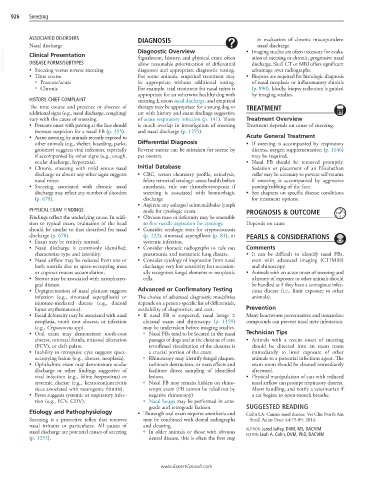Page 1845 - Cote clinical veterinary advisor dogs and cats 4th
P. 1845
926 Sneezing
ASSOCIATED DISORDERS DIAGNOSIS in evaluation of chronic mucopurulent
nasal discharge.
Nasal discharge Diagnostic Overview • Imaging studies are often necessary for evalu-
VetBooks.ir Clinical Presentation Signalment, history, and physical exam often ation of sneezing or chronic, progressive nasal
DISEASE FORMS/SUBTYPES
discharge. Skull CT or MRI offers significant
allow reasonable prioritization of differential
advantage over radiographs.
• Sneezing versus reverse sneezing
For some animals, empirical treatment may
• Time course diagnoses and appropriate diagnostic testing. • Biopsies are required for histologic diagnosis
○ Peracute/acute be appropriate without additional testing. of nasal neoplasia or inflammatory rhinitis
○ Chronic For example, trial treatment for nasal mites is (p. 890). Ideally, biopsy collection is guided
appropriate for an otherwise healthy dog with by imaging studies.
HISTORY, CHIEF COMPLAINT sneezing ± serous nasal discharge, and empirical
The time course and presence or absence of therapy may be appropriate for a young dog or TREATMENT
additional signs (e.g., nasal discharge, coughing) cat with history and exam findings suggestive
vary with the cause of sneezing. of acute respiratory infection (p. 141). There Treatment Overview
• Peracute onset with pawing at the face should is much overlap in investigation of sneezing Treatment depends on cause of sneezing.
increase suspicion for a nasal FB (p. 355). and nasal discharge (p. 1255).
• Acute sneezing by animals recently exposed to Acute General Treatment
other animals (e.g., shelter, boarding, parks, Differential Diagnosis • If sneezing is accompanied by respiratory
groomer) suggests viral infection, especially Reverse sneeze can be mistaken for sneeze by distress, oxygen supplementation (p. 1146)
if accompanied by other signs (e.g., cough, pet owners. may be required.
ocular discharge, hyporexia). • Nasal FB should be removed promptly.
• Chronic sneezing with mild serous nasal Initial Database Sedation or placement of an Elizabethan
discharge or absent any other signs suggests • CBC, serum chemistry profile, urinalysis, collar may be necessary to prevent self-trauma
nasal mites. feline retroviral serology: assess health before if sneezing is accompanied by aggressive
• Sneezing associated with chronic nasal anesthesia, rule out thrombocytopenia if pawing/rubbing of the face.
discharge may reflect any number of disorders sneezing is associated with hemorrhagic • See chapters on specific disease conditions
(p. 678). discharge for treatment options.
• Aspirate any enlarged submandibular lymph
PHYSICAL EXAM FINDINGS node for cytologic exam. PROGNOSIS & OUTCOME
Findings reflect the underlying cause. In addi- • Obvious mass or deformity may be amenable
tion to typical exam, evaluation of the head to fine-needle aspiration for cytology. Depends on cause
should be similar to that described for nasal • Consider serologic tests for cryptococcosis
discharge (p. 678). (p. 223), sinonasal aspergillosis (p. 81), or PEARLS & CONSIDERATIONS
• Exam may be entirely normal. systemic infection.
• Nasal discharge is commonly identified; • Consider thoracic radiographs to rule out Comments
characterize type and laterality. pneumonia and metastatic lung disease. • It can be difficult to identify nasal FBs,
• Nasal airflow may be reduced from one or • Consider cytology of impression from nasal even with advanced imaging (CT/MRI)
both nostrils due to space-occupying mass discharge; very low sensitivity but occasion- and rhinoscopy.
or copious mucus accumulation. ally recognizes fungal elements or neoplastic • Animals with an acute onset of sneezing and
• Stertor may be associated with nasopharyn- cells. a history of exposure to other animals should
geal disease. be handled as if they have a contagious infec-
• Depigmentation of nasal planum suggests Advanced or Confirmatory Testing tious disease (i.e., limit exposure to other
infection (e.g., sinonasal aspergillosis) or The choice of advanced diagnostic modalities animals).
immune-mediated disease (e.g., discoid depends on a patient-specific list of differentials,
lupus erythematosus). availability of diagnostics, and cost. Prevention
• Facial deformity may be associated with nasal • If nasal FB is suspected, nasal lavage ± Many heartworm preventatives and isoxazoline
neoplasia, tooth root abscess, or infection choanal exam and rhinoscopy (p. 1159) compounds can prevent nasal mite infestation.
(e.g., Cryptococcus spp). may be undertaken before imaging studies.
• Oral exam may demonstrate tooth-root ○ Nasal FBs tend to be located in the nasal Technician Tips
abscess, oronasal fistula, mucosal ulceration passages of dogs and at the choanae of cats; • Animals with a recent onset of sneezing
(FCV), or cleft palate. retroflexed visualization of the choanae is should be directed into an exam room
• Inability to retropulse eyes suggests space- a crucial portion of the exam. immediately to limit exposure of other
occupying lesion (e.g., abscess, neoplasia). ○ Rhinoscopy may identify fungal plaques, animals to a potential infectious agent. The
• Ophthalmic exam may demonstrate ocular turbinate destruction, or mass effects and exam room should be cleaned immediately
discharge or other findings suggestive of facilitate direct sampling of identified afterward.
viral infection (e.g., feline herpesvirus) or lesions. • Physical manipulation of cats with reduced
systemic disease (e.g., keratoconjunctivitis ○ Nasal FB may remain hidden on rhino- nasal airflow can prompt respiratory distress.
sicca associated with neurogenic rhinitis). scopic exam (FB cannot be ruled out by Abort handling, and notify a veterinarian if
• Fever suggests systemic or respiratory infec- negative rhinoscopy) a cat begins to open-mouth breathe.
tion (e.g., FCV, CDV). ○ Nasal lavage may be performed in ante-
grade and retrograde fashion. SUGGESTED READING
Etiology and Pathophysiology • Thorough oral exam requires anesthesia and Cohn LA: Canine nasal disease. Vet Clin North Am
Sneezing is a protective reflex that removes may be combined with dental radiographs Small Anim Pract 44:75-89, 2014.
nasal irritants or particulates. All causes of and cleaning.
nasal discharge are potential causes of sneezing ○ In older animals or those with obvious AUTHOR: Jared Jaffey, DVM, MS, DACVIM
EDITOR: Leah A. Cohn, DVM, PhD, DACVIM
(p. 1255). dental disease, this is often the first step
www.ExpertConsult.com

